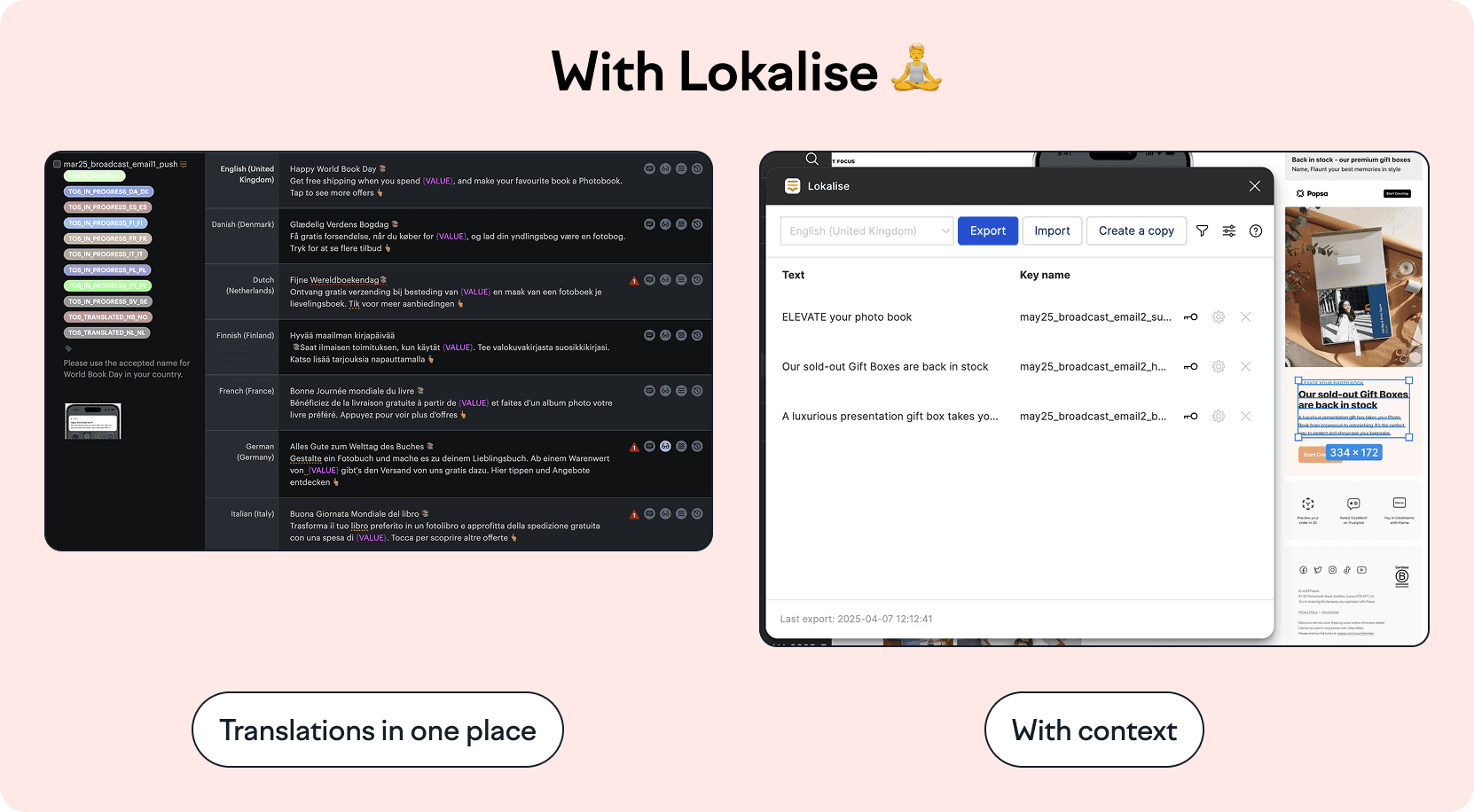Quality up, costs down: the Popsa marketing team delivered top-quality translations 75% faster at 20% less cost
One single source of truth
20% lower translation costs
Higher localization quality
Popsa 🌍 Lokalise: a summary
🧳 The requirement: One place where the marketing team at Popsa can store all their translations and manage the localization process, without spreadsheets and manually copying and pasting translations.
💡The solution: The Popsa marketing team connected Lokalise to their existing tech stack through plug-and-play integrations so they could:
- Unify teams, tasks, and content
- Keep all their translations in one place
- Assign translation tasks to their trusted LSP, Translated, with brand assets attached and custom workflows set up inside Lokalise
- Collaborate directly with Translated’s linguists on campaign and brand-critical content
- Build a translation memory enabling them to reuse translations
🏅 The results:
- One single source of truth
- Product and marketing teams work together more
- Translation costs were cut by up to approximately 20%
- Translation quality is no longer seen as a performance concern
About Popsa
Popsa is an app-based business that makes photobook creation easy and accessible. Their mission is to help people reconnect with their memories by transforming the photos stored on their phones into photo books and products. The company operates in dozens of countries around the world, supporting 12 languages, with 50-60% of its revenue coming from non-English markets.
Challenge: Misalignment between teams and manual localization work in spreadsheets led to inefficient processes
The Popsa team faced a significant challenge: their localization processes were fragmented between departments, creating inefficiencies and quality issues.
While the engineering team was using Lokalise to store app keys, send UI copy for translation, and push translations to their apps, the marketing team struggled with a slow and manual localization process:
"I inherited a horrendous system of spreadsheets. It was just like, here's a load of words and lines, please translate them, then we'd get them back and copy and paste again from that spreadsheet into marketing assets," says Tom Rees, Marketing Operations Manager at Popsa.
This disconnected process meant:
- No single source of truth for translations across the company
- Manual, error-prone copying and pasting for marketing content
- Inability to leverage existing translations across departments
- Inefficient use of time that could be spent on quality improvement
- Difficulty briefing external vendors effectively
Since working with Translated through Lokalise, Popsa has been able to streamline communication and provide linguists with better context.

Solution: A single source of truth for the whole business
When Tom found out that the product and engineering teams were already using Lokalise, he saw an opportunity to iron out operations across the company.
“My primary motivation was let's have a tidier process and a single source of truth for where our translations live as a business.”
It was easy for him to connect the marketing team’s tech stack to Lokalise through plug-and-play integrations with Storyblok and Figma.
This allowed Popsa to easily store and manage translations for:
- Scripts for paid social videos and ads
- CRM email campaigns for existing customers
- Website SEO content
- Product UI elements
As an added benefit, cross-team collaboration between the product and marketing teams improved.

Implementation: Plug-and-play integrations, translation memory, and task templates to speed up the process
1. Tom connected the tools the marketing team uses day-to-day
Popsa’s website is hosted in Storyblok, so Tom set up the integration with Lokalise. That means that whenever the content is published in Storyblok, it’s automatically sent to Lokalise for translation.
He also set up the Figma plugin to extract copy from designs and push it straight to Lokalise.
2. Set up efficiency tools
Tom set up translation memory and has built it up over time to automatically populate content with pre-approved translations.
“If somebody needs to know, what's our translation for this commonly used phrase, they have somewhere to connect up to find that.”
For other translations, he sends them to Translated (Popsa’s language service provider) directly through Lokalise with important brand documents attached by default, so that whoever is translating has important business context.
“I've got a task template inside Lokalise so I can quickly set up tasks for Translated, attach key assets, and make it easier for them to deliver high-quality translations even under tight timelines.”

3. Team organization
As for who does what, Tom handles all the marketing material while the front-end team handles localization on the engineering side.
To avoid noise, each team has a separate project within Lokalise, so they only see tasks relevant to them.
Results: Increased productivity, improved translation quality, and lower localization costs
Since switching to Lokalise, Tom has doubled his output. Now he has twice as much time for quality assurance within the same resource allocation (he dedicates about 15 to 20% of his time to localization).
“The fact I'm able to do that hygiene stuff within the same amount of time and that everything is in one place can help lead to better outcomes.”
This includes making sure variables are in place, the context for each key is available, and key names in Figma are clear.
Since implementing Lokalise and partnering with Translated’s expert linguists for marketing localization, the frequency of senior management calling out translation quality as a performance concern has dropped to near zero. Before the customer support team was often receiving comments about awkward and literal translations.
Now, the Popsa team can quickly populate marketing assets while reducing turnaround times and translation costs—without compromising quality.
Lokalise and Translated’s impact on speed, quality, and cost:
- 75% faster turnaround times: The turnaround times for the Storyblok-integrated project are roughly 75% faster, supported by automation and Translated’s responsiveness on high-volume requests
- 20% lower translation costs: Translation costs are down approximately 10% thanks to better cost-per-word agreements with Translated, made possible by the operational transparency provided by Lokalise. Translation memory (TM ), which allows the Popsa team to store and reuse past translations, has further reduced costs by around 10%, which is increasing as the TM grows
- Improved quality: Translation memory and working with the same team at Translated helped improve translation quality and consistency.
- A website in 14 languages: Popsa’s new website is now in all 14 languages they operate in, up from a handful. Previous translations were hard-coded, which was laborious to build and maintain and meant they simply didn't adapt the website before.
When the team starts publishing website content, Tom estimates the Storyblok Lokalise integration will save hours per page/article.
Translated also helped Popsa get through a high volume of content, including email campaigns and ads, during key commercial periods like Black Friday and new market launches, delivering translations with reliability and quality.
With Lokalise and Translated working in sync, Popsa finally had the tools and the linguistic expertise to manage localization without bottlenecks.
Future: Scaling translations with AI post-editing
Looking ahead, Popsa aims to enrich the memory experience by incorporating additional contextual data into their products, such as weather conditions during vacations, news headlines, or music charts from when a child was born, to create deeper narratives around people's memories.
To scale this, they are already exploring ways to combine AI-driven translation with Translated’s human review, particularly for editorial content that’s more emotionally charged, ensuring scale without sacrificing brand tone or emotional nuance.
Eventually, Tom wants to set up fully automated workflows so the team can focus more on quality.
“Being able to dedicate more time to actually reviewing translations and sense checking and more of the human stuff and leaving that kind of just operational stuff in the background to happen by itself is a big time saver and really helps.”
He also wants to focus more on his main responsibilities as an operations manager. Localization is not really Tom’s job— “It's a responsibility that I have to take on alongside lots of other things.”
Take your products global with Lokalise
Talk to one of our experts to learn how to localize with confidence.
Case studies

Behind the scenes of localization with one of Europe’s leading digital health providers
Read more Case studies
Support
Company
Localization workflow for your web and mobile apps, games and digital content.
©2017-2025
All Rights Reserved.
